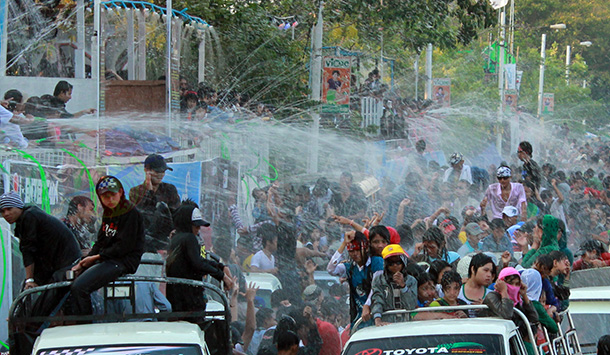RANGOON — Young people in Rangoon are eagerly gearing up for Thingyan, a four-day Buddhist water festival that begins in two weeks to celebrate the Burmese New Year.
This year’s festival is expected to be the biggest yet, with more platforms known as pandals from which to drench passing pedestrians with water cannons and hoses.
“Since the middle of March, my friends and I have been preparing for the festival by buying new clothes and pandal tickets,” says 20-year-old Su Pyae Honey, adding that she always prepares in advance for her favorite festival. “All tiredness from the year goes away after playing in the water festival.”
Wai Yan Linn, a 19-year-old in Mandalay, Burma’s second-biggest city, plans to spend two days playing at a pandal and the rest of the festival riding around town on a motorcycle.
“I’m really excited. As soon as I hear Thingyan music and songs, I want to dance,” he says, adding that he enjoys the camaraderie and playfulness of the festival.
The Yangon City Development Committee (YCDC), the municipal body that manages the festival, has permitted 57 large pandals and 36 medium pandals this year, up from 34 large pandals and seven medium pandals last year, according to YCDC official Myo Lwin.
“People can play with water at more pandals this year,” he says.
Last year, security concerns kept some people home. Just weeks before the festival, anti-Muslim riots in the central Burma town of Meikhtila led to fears of the possibility of further unrest in Rangoon. Some worried that pandals could be targeted by bomb attacks, but the festival proceeded without incident.
In 2010, a deadly bomb went off at a pandal near Kandawgyi Lake during the water festival. Since then, the government has ordered pandal organizers to set up at least four CCTV cameras and hire private security guards, but the turnout of festival goers has been smaller.
“Last year, pandals near Kandawgyi Lake were not crowded because of the rumors. There are no rumors this year, so I hope the Rangoon water festival is more massive than last year,” Myo Lwin of YCDC says.
Each pandal has a name and different decorations. Aung Myat Phyo, an organizer of the Black Culture pandal, says people will be charged 37,000 kyats (US$37) for a ticket to play on the pandal throughout the festival, with lunch and refreshments included. He added that the costs of operating a pandal were increasing year by year.
A large pandal—about 120 feet long and capable of holding up to 1,500 people—costs around 40 million kyats to operate, not counting the additional costs of decorations, CCTV cameras and security guards. It takes five to eight days to finish construction of a large pandal, and organizers must pay a deposit of 7.5 million kyats to the YCDC. That money is not returned if organizers break certain rules, such as operating the pandal after 6 pm, or if damage is done to the surrounding environment.
“Although organizing a pandal isn’t profitable, I like the atmosphere that our pavilion creates. The place is empty at first, but when the festival comes the pandal brings decorations and lights, and people are dancing onstage. It’s really amazing,” Aung Myat Phyo says.
“Everyone wants to have fun in Thingyan,” he adds. “If there’s less worry, people will be happier.”

















